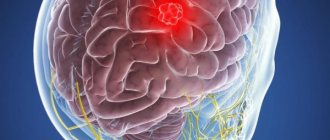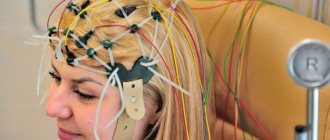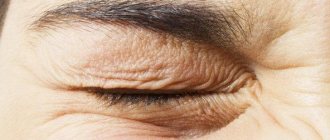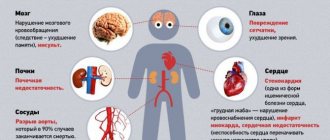The right side of the head hurts and radiates to the eye due to many provoking factors. Discomfort worsens a person’s quality of life, significantly interfering with work and rest.
To determine the cause of the pathology, you need to undergo a thorough examination.
How long have you had this pain syndrome?
- Several days (26%, 1,072)
- First day (21%, 878 Votes)
- Several months (13%, 521)
- Week (10%, 420)
- Several weeks (10%, 394)
- About a month (9%, 352)
- Chronic form (6%, 263)
- About a year (6%, 235)
Total voters: 4 136
Loading …
Consult a doctor!
The site provides reference information . Adequate diagnosis and treatment of the disease is possible under the supervision of a conscientious doctor . Any medications have contraindications. Consultation with a specialist and detailed study of the instructions is necessary! Be sure to make an appointment with your doctor .
Why does the right side of my head hurt and radiate to the eye?
Migraine manifests itself as severe pain from one hour to several days and is accompanied by dizziness, pain in the eyes, visual disturbances in the form of black spots, flashes of light, and blurriness.
There are 2 subtypes of migraine: without aura and with aura. The second type is distinguished by the appearance of specific symptoms before the onset of an attack.
Occipital neuralgia is a lesion of the lesser and greater occipital nerves in the cervical region on the right. Occurs as a result of injuries, infection, tumors, hemorrhages, diabetes mellitus, systemic diseases, degenerative changes in the bones and spine. A static posture with the head down can provoke the disease.
Inflammation of the oblique eye muscle. Dull or severe pain appears in the inner corner of the eye and above it. The cause is considered to be autoimmune and rheumatoid diseases, conditions with a history of inflammation in connective tissues. In persons predisposed to migraine, an exacerbation of the attack is possible.
Pathologies of the paranasal sinuses are an inflammatory process accompanied by swelling. Appears when exposed to allergenic irritants, bacteria and viruses, fungal infections. When the sinus is blocked, the head, eye, neck hurts, chills, cough, and general weakness appear.
Referred pain – transmitted from the affected organ to the eye and right side of the head. It happens with brain damage, cervical pathologies, cervicalgia.
Cluster headaches are intense, unilateral attacks that can last up to 12 weeks without treatment. They radiate to the temple, neck, shoulders, any part of the head, eyes. They appear suddenly and may occur sporadically several times a day for up to 3 hours. The eye may turn red, watery eyes and swelling of the eyelid may appear.
Diseases
- Migraine . Often, temporal pain on the right or left side, radiating into the eye, may indicate a migraine. No one has yet been able to answer the question of what causes migraine, what are the mechanisms of the disease. Meanwhile, migraines can bother you for a long time and painkillers may not be effective. Unbearable pain usually occurs on one side.
- Cephalgia . Harris migraine neuralgia is another name for cluster pain in the head. Very similar to a migraine, it is characterized by high blood pressure, redness of the face, and burst blood vessels in the eyes. By nature - wild, unbearable, localized in one half, passes in attacks, lasts from 15 minutes to two hours, several times a day. Medicines often cannot help. With such pain, it is impossible to find the correct position of the head in order to somehow alleviate the condition. The causes of such pain are also not fully understood.
- Glaucoma . Increased eye pressure begins with pain in the back of the head and moves to one side of the head on the right or left, affecting the right or left eye. In this case, the eye turns red, vision decreases, and sometimes nausea appears.
- Hypertension . Often manifests as pain on one side. When the right side of the head hurts and puts pressure on the right eye, there is a feeling that the eye is sticking out.
- Increased intracranial pressure is characterized by sharp, sudden pain shooting into the eye.
- Infectious diseases can be accompanied by pain on one side of the head: unilateral sinusitis, sinusitis, sinusitis, and a more severe disease - meningitis also begins with a unilateral headache radiating to the eye and temple.
- Traumatic brain injury . The pain is localized in the area that is affected. Occurs when there is a blow or bruise to the right temporal lobe. Often accompanied by nausea.
- Brain tumor , pain is concentrated in the part of the brain where the tumor appeared.
- Eye injury is almost always accompanied by pain in the organ of vision and headache.
What to do if there is pain
It is impossible to determine on your own the causes of pain in the head on the right behind the eye. This is a signal of eye diseases, a sign of an acute inflammatory process in the body. Painful discomfort in the head needs to be monitored.
To do this, they keep a diary in which they write down the date and time of pain, accompanying circumstances, the nature of the attack and additional symptoms. The records will help the doctor figure out why the pain occurs.
To reduce the frequency of pain, you need to adhere to the following rules:
- Choose an orthopedic mattress and a comfortable pillow in a specialized store;
- If you are in a static position for a long time, do a light warm-up every 1-2 hours, change the position of your head;
- For problems with the cervical vertebrae, a cervical collar is appropriate; it relieves the load on the neck and maintains its correct position;
- Strengthening the muscles of the neck and shoulder girdle with physical therapy;
- Massage with ice cubes based on a decoction of medicinal plants (chamomile, calendula, sage) for problem areas of the neck;
- Neck massage with a powerful stream of warm water from the shower head, periodic visits to the sauna.
A nutritious diet combined with the right regimen will reduce the risk of pain that occurs in a person due to overwork and a “knocked down” daily routine. If your head starts to hurt after rest, cephalalgia is not relieved by painkillers, and you should not postpone visiting a doctor. Discomfort on the right side can signal a surge in pressure, inflammation of the brain and other diseases.
If it hurts on the left
Pain on the left side can be an independent disease or a consequence of the reaction of another dangerous disease.
Pain receptors are distributed throughout the body, including in the blood vessels, nervous system and cerebral cortex.
Let's look at the reasons that cause discomfort on the left side.
Fatigue
Modern life is full of stress and nervous tension. Due to overwork, a person may have an eye and headache on one side. This is how spasmodic phenomena manifest themselves in the arteries located in the shoulder joint. The blood flow is disrupted and a pulsating area appears. It does not go away even after resting or relieving stress. To prevent the appearance of such symptoms, it is necessary to ensure adequate sleep and minimize stressful situations.
Severe attack of headaches
The pain syndrome is felt in the head, with a gradual transition to the left side and radiates to the eye.
Migraine is characterized by pain and a feeling of stiffness in the limbs. Women are more likely than men to suffer from migraine pain.
Which doctor should I contact?
Often, after physical exertion or mental stress, people feel worse. The nature of the pain can be varied. Compressive, pressing, throbbing pain in one side of the head is possible.
Pain during exercise is often functional in nature. They can occur for many reasons:
- Changes in temperature and atmospheric pressure;
- Stressful state during physical activity;
- Heat and stuffiness in the room;
- Dehydration is often the cause of headaches;
- Eat a large meal before training;
- Overweight people often suffer from hypoxia during exercise.
The likelihood of illness is higher in people with specialties: programmer, accountant, driver, who spend many hours at the computer or constantly strain the muscles of the eyes and neck.
Persistent cephalgia, which occurs regularly, requires mandatory consultation with a doctor in order to exclude serious pathology and prescribe the correct treatment in a timely manner.
The initial appointment should be made by a therapist. He will conduct a general examination, measure blood pressure, write out directions for tests and refer you to specialists.
If you have unpleasant sensations in the head and neck area, it is good to have a home blood pressure monitor, with which you can track pressure surges in different life situations. A rise in blood pressure after physical activity can often be the cause of pain.
The doctor gives a referral to an otolaryngologist to rule out chronic otitis media, sinusitis or inflammation of the maxillary sinuses (sinusitis).
The doctor can give a referral to an ophthalmologist to identify changes in the fundus and possible vision defects.
Most of the causes of discomfort in the head are associated with neurological symptoms, so diseases accompanied by head pain syndrome are treated by a neurologist.
Reasons for appearance
Although migraine has been known to people since ancient times, its causes are not fully known to this day. Studies have revealed that migraine attacks occur as a result of changes in vascular tone.
In almost 70% of cases, a relationship was found between migraine in the father and mother and in children, and it is not the disease itself that is inherited, but the tendency to it. Migraine attacks are often associated with the onset of menstruation (more than 70%).
The factors that provoke the appearance of migraines are very diverse and there are quite a lot of them. From feelings of fear or anger to drinking a cup of coffee. Let's list some of them. Usually this is overheating in the sun, a change in atmospheric pressure, or being in a stuffy, poorly ventilated place.
Excess or lack of sleep, migraine can also trigger normal daytime sleep . Disruption in work and rest routines, endocrine shifts (menstruation, pregnancy); exposure to external stimuli (noise, bright flickering light); severe hunger, untimely eating, consumption of certain foods such as chocolate, citrus fruits, mushrooms, honey, crabs, certain types of fish and meat (in particular pork), consumption of alcoholic beverages (in particular red wine). Different smells (food, flowers, perfume, etc.) Cold, strong wind, sea motion. A person’s stay in a warm or cold room; climatic factors. Physical fatigue, diseases of internal organs, various infections.
What tests are usually prescribed?
At an appointment with a neurologist, a physical examination of the patient is performed: basic neurological reflexes are checked and the neck muscles are examined.
The doctor writes out a referral for tests: general blood test, biochemical blood test, blood sugar test.
A general blood test with an increase in ESR or an increased content of leukocytes indicates inflammation in the body.
Blood biochemistry may indicate a deficiency of one of the vital elements, which leads to discomfort in the head area.
Low blood glucose levels are often accompanied by cephalgia, dizziness and weakness.
The doctor may write a referral for additional tests:
- The gas composition of arterial blood can reveal cerebral hypoxia.
- A blood test for hormones determines various abnormalities in the functioning of the hypothalamus.
A neurologist can give a referral to one or more diagnostic methods:
- Magnetic resonance imaging (MRI) - excludes the presence of various neoplasms (tumors and cysts), aneurysms. The photographs clearly show post-traumatic defects, neurodegenerative abnormalities, and changes in blood vessels affected by atherosclerosis.
- Computed tomography (CT) is the most informative method for studying the brain. It gives a clear idea of pathological changes in the skull and brain, pathology of bone tissue, blood vessels and brain structures. Provides information about the consequences of traumatic brain injuries. The disadvantage of this method is the significant radiation dose during the study.
- Electroencephalography gives an idea of the presence of pathological changes in blood vessels and impaired cerebral circulation.
- Doppler ultrasound (ultrasound of the vessels of the head and neck) - shows the presence of atherosclerotic plaques in the arteries; narrowing and tortuosity of the arteries, leading to brain hypoxia; peripheral vascular resistance.
- Rheoencephalography (REG) - gives an idea of the tone and blood flow of blood vessels. Using REG, the following are diagnosed: hypertension, atherosclerosis, vegetative-vascular dystonia.
- MRI of the cervical spine - the presence of cervical osteochondrosis can cause pain in the head and neck, which intensifies when turning the head.
- Rheovasography of cerebral vessels (RVG) - shows the quality of blood flow through the great vessels, evaluates collateral circulation.
- Radiography will be less known. In the image you can only see the bone structures of the skull, soft tissues are not visible.
There is no need to panic when scheduling such a serious examination. The doctor excludes rare severe pathologies and looks for the causes of the pain process.
Based on the studies, if no serious organic lesions are found, the cause of the disease is usually diagnosed. It develops as a result of: vascular spasms, cerebral hypoxia, hypertonicity of cerebral vessels, hormonal imbalances, vegetative-vascular dystonia or osteochondrosis, provoked by physical or psycho-emotional stress.
Causes and main diseases
When you have a headache and pressure on your eyes, it is important to correctly determine the cause of the pathology. Usually, when a headache appears, it immediately spreads to the eyes. But it happens that everything happens the other way around. First the eyes begin to hurt, and then the head.
Doctors say that a headache is a symptom of one of many diseases. There are many reasons for its appearance. The main ones include:
- eye diseases;
- high blood pressure;
- head injuries;
- fatigue;
- migraine;
- infectious diseases;
- myopia.
The most obvious causes of pain are fatigue and overexertion. In this way, the body signals that it needs rest. In some cases, according to scientists, pain may occur due to eating unhealthy foods. For example, fast food or caffeine.
Sometimes pain can signal the presence of such pathologies in the body:
- Diseases of ENT organs. Such pathologies usually occur with high fever, intoxication of the body and pain in the head. Pain syndrome is provoked by the release of metabolic products of pathogenic microbes that provoked the disease. Various ailments have their own symptoms and course. For example, in the presence of frontal sinusitis, the pain will intensify at night and in the morning, and with ethmoiditis, it spreads to the area of the organs of vision and forehead.
- Viral and infectious pathologies. In this case, there is poisoning of the body, which is manifested by nausea, weakness and pain in the head. The pain syndrome can be localized in all parts of the head. The most dangerous diseases are meningitis and encephalitis. They are characterized not only by severe pain, but also by infection of the brain, which can become a serious danger to human life.
- Pathologies of the heart and blood vessels. Changes in blood pressure cause pain in the head. With high blood pressure, they first appear in the eye area, with low blood pressure - in the forehead area.
- Pathologies of the nervous system. Pain in the eyes and front of the head is a symptom of neuralgia, neuroses and depression. Also, such signs may appear due to overwork and sleep disturbances. Often, pain occurs due to inflammation of the trigeminal or optic nerve. In this case, it first occurs in the organs of vision, and then moves to the front of the head. In addition, there is tinnitus and pressure in the organs of vision.
- Eye diseases. Pain can be a consequence of myopia or farsightedness, dry eye syndrome, glaucoma, both closed and open.
- Poisoning. Intoxication can be caused by low-quality alcohol, chemicals, medications, and food. It leads to pain in the head and nausea.
- Migraines often manifest as pain in the forehead and eyes. The attack begins gradually. First, discomfort is felt in the temples, then the painful sensations move to other areas of the head. Such sensations may be present for one to three days.
- Head injuries. A concussion, bruise, or hematoma negatively affects brain activity.
- Tumors of the brain or temporal bone. Benign or malignant neoplasms can cause pain because they lead to increased pressure in the skull and disrupt the blood supply to the brain and the transmission of nerve impulses.
- Cervical osteochondrosis, intervertebral hernia. When bones and cartilage in the cervical spine are damaged, blood supply to the arteries of the brain is disrupted, oxygen starvation begins, and a lack of glucose occurs. All this leads to the development of headaches.
- Other reasons for the development of pain in the forehead and eyes include the wrong choice of lenses or glasses, prolonged exposure to a dusty room, bright light or strong wind.
Groups of drugs effective for episodic attacks of pain
Medicines to treat this pathology are non-steroidal anti-inflammatory drugs (NSAIDs). They have an analgesic effect, relieve inflammation, and eliminate swelling.
Often prescribed:
- Ibuprofen-400 mg per day;
- Ketoprofen-100 mg/s;
- Naproxen-500 mg/s;
- Meloxicam-7.5-15 mg/s;
- Celecoxib-200 mg/s.
Most NSAIDs have a negative side effect: with long-term use, they negatively affect the organs of the gastrointestinal tract, including the development of drug-induced gastritis.
Medicines Meloxicam and Celecoxib are new generation drugs that do not have a negative effect on the gastrointestinal tract. The disadvantages of using these drugs include the relatively high price.
Analgesics are often used at home to relieve an attack. They do not treat the disease, but only relieve pain. Drugs in this group are suitable for stopping episodic attacks, but their systematic use leads to the occurrence of abuse syndrome.
During an attack of pain, you can take Paracetamol-100 mg, Citramon, Analgin-500 mg or Mig 200-400 mg.
If the examination revealed the appearance of cephalgia after exercise as a result of increased blood pressure, the doctor will prescribe medications prescribed at an early stage of the development of hypertension. These include: vasodilators, ACE inhibitors, diuretics, calcium channel blockers.
Self-prescribing antihypertensive drugs is unacceptable. Self-medication leads to serious consequences.
For muscle tension, drugs from the group of muscle relaxants are used as part of complex treatment. They relax the spasmodic muscles of the head and neck, relieving pain of a spastic nature, and help restore blood flow.
Often prescribed:
- Mydocalm-150-450 mg per day;
- Sirdalud (Tizanidine) - 4 mg/s;
- Baclofen-15 mg/s.
Nootropic drugs are often prescribed as part of complex treatment: Phenibut, Nootropil, Glycine. Nootropics have an activating effect on brain function and increase its resistance to damaging factors. The drugs improve cerebral circulation and eliminate the consequences of traumatic brain injuries.
Sedatives in combination with basic drugs lead to muscle relaxation and decreased vascular tone. Taking tranquilizers helps relieve pain, but this type of medication quickly causes drug dependence with withdrawal symptoms.
Sedatives that are not addictive: Afobazol, Atarax; alcohol tinctures of valerian, motherwort, Maryina root.
For severe attacks, a combination of drugs is used: Sirdalud 2 mg + Aspirin 500 mg or Analgin 250 mg + sedative.
The use of vitamin B complexes has proven itself. Vitamins B1, B6, B12 have a beneficial effect on the central nervous system and restore the structure of nerve tissue. Vitamin complexes are often prescribed: Neuromultivit, Milgamma, Neurovitan.
If attacks of pain recur more than 10 times a month, a course of treatment with Ibuprofen at a dose of 400 mg per day for 2-3 weeks and treatment with muscle relaxants is prescribed for 2-4 weeks.
There is no single scheme for pain relief. Depending on the cause, each patient needs an individual selection of drugs.
Treatment of chronic disease
Sometimes cephalalgia becomes chronic. The pain occurs every day, continuously, with varying degrees of intensity.
Tricyclic antidepressants are prescribed for a long course of 2-6 months. They relieve pain and help normalize the psycho-vegetative state of the nervous system.
Amitriptyline 10-100 mg/s is most often prescribed, the dose is increased gradually. The drug relieves pain well, but has many negative side effects and is addictive.
As an alternative, selective serotonin reuptake inhibitors are prescribed: Fluoxetine, Paroxetine, Sertraline. The course of treatment is at least 2 months. These drugs have less toxicity.
In addition to prescribing drug therapy, the doctor will recommend massage, a course of physiotherapy or acupuncture.
Contraindications for use
Any medications have both indications for use and contraindications. The instructions attached to them indicate possible side effects resulting from their use, cases in which their use is not recommended.
General, frequently noted contraindications to the use of painkillers:
- Individual intolerance to the drug or drug components.
- Pregnancy, lactation period. This is due to the high ability of drugs to penetrate the placenta and be secreted into milk, which adversely affects the life of the fetus or newborn child. In extreme cases, when it is impossible to get rid of long-term pain in any other way, it is possible to use Paracetamol.
- Ulcer, erosive lesions of the digestive organs.
- Hepatitis.
- Dermatous manifestations.
- Diseases of the cardiovascular system.
- Bronchial asthma.
- Hematopoiesis disorder.
- Allergy.
- Impaired liver and kidney function. The use of medications is recommended only under the direct supervision of a physician.
- Childhood.
Acetylsalicylic acid is not used under the age of 14 years due to the risk of developing Reye's syndrome. This is a form of acute liver failure found in pediatrics.
Nonsteroidal anti-inflammatory drugs have an extensive list of contraindications for their use, especially for inflammatory diseases of the gastrointestinal tract. The exception is Paracetamol. It has a gentle effect on the body, without blocking the process of prostaglandin synthesis in peripheral tissues.
Frequent use of medications for pain is contraindicated for all categories of people.
The result of long-term medication use will be:
- Strengthening, more frequent attacks of pain, migraines;
- Development of pain into a chronic form;
- Development of pathologies of the digestive system;
- Provoking an allergic reaction;
- Disturbances in the functioning of the liver and kidneys.
Dangerous combination with other medications
Taking several medications together can cause an undesirable reaction in the body: weaken the effect of the drug, overly enhance its effect, cause side effects, or even sometimes lead to death. People suffering from chronic diseases should take this seriously.
The combination of the following drugs is not recommended:
- NSAIDs and Cardiac aspirin. These drugs compete with each other in the body for the same enzyme. Their combined use reduces the effectiveness of aspirin. Both drugs have side effects on the stomach lining, which increases the risk of ulcers and stomach bleeding.
- NSAIDs and Warfarin. Causing a side effect in the form of decreased blood clotting, NSAIDs in interaction with Warfarin increase the risk of developing dangerous bleeding.
- Painkillers and sedatives. The simultaneous use of such drugs increases their toxic effects on the body, which leads to an overdose. The result is a decrease in breathing rate and heart contractions, sometimes to a fatal level.
- Painkillers and antidepressants. The combined effects of such drugs provoke the formation of gastric and intestinal bleeding. Accompanying symptoms: anxiety, increased body temperature, increased breathing and heart rate.
- Strong sedatives, Phenazepam, and antibiotics. The group of antibiotics is most dangerous in its interaction with other drugs. This is due to the serious negative side effects that can occur when consuming them.
Taking painkillers requires caution and care. Avoid systematic use of medications without a doctor’s recommendations, and do not combine medications with other medications to avoid side effects.
Do not prescribe a course of treatment on your own, without prior consultation with specialists. Compliance with these rules will allow you to get rid of pain without negative and dangerous consequences for the body.
Complications of various types of headaches
Headaches are:
- Primary
- Secondary.
Complications of primary headache
In particular, she has no complications. It includes hemicrania, tension-type headache, PHB, trigeminal autonomic cephalgia.
Migraine is a one-sided, throbbing pain that occurs due to bright light, noise, fatigue, eating foods such as chocolate, spices, cheese and wine. The disease is based on irritation of the nervous system of the head and neck, after which the blood joints narrow and sharply expand. Main complications of migraine:
- Status migraine is a severe attack. The disease causes swelling of the brain, seizures, stroke, heart attack,
- Migraine infarction - a migraine attack with an aura lasting 60 minutes,
- Migraine-associated seizures,
Complications of secondary headache
It occurs as symptoms of other diseases such as head trauma, cerebral vascular damage, infection, mental illness, damage to homeostasis and others. It disappears when the underlying disease is treated.
Intracranial hypertension
Intracranial hypertension is an increase in intracranial pressure. When pressure increases to 30 mmHg, blood circulation in the brain is disrupted. If it rises above 50 mm Hg, death is possible. A person experiences a pressing headache, nausea (in the morning), fatigue, drowsiness, depression of consciousness and prolonged hiccups. Pathology can cause structural damage.
Intracranial hypertension has serious complications:
- Cerebral ischemia, resulting from compression of the brain substance,
- Dislocation – displacement of brain structures,
- Wedging.
Giant cell arteritis (Horton's disease)
Giant cell (temporal) arteritis is an inflammation of the lining of the red blood joint, which affects the arteries of the temporal region of the head. The causes of the disease have not been fully identified. The disease occurs due to immune disorders. Pathogens enter the body and produce antibodies that cause inflammation.
Complications:
- Blindness. Vision loss is irreversible. Occurs as a result of impaired blood supply,
- Stroke. Rarely found
- Aortic aneurysm. Can happen at any time and lead to internal bleeding.
Meningitis
Meningitis is a lesion of the meninges. Pathogenic microorganisms (viruses, bacteria, protozoa and fungi) cause disease. When sick, patients experience headaches and nausea.
Complications after meningitis:
- Paralysis,
- Blindness,
- Deafness,
- Ischemic stroke,
- Intellectual impairment
- Paresis,
- Convulsive syndrome,
- Hydrocephalus,
- Epilepsy,
- cerebral edema,
- SIADH
- Speech disorders
- Brain abscess
- Aneurysm,
- Transverse myelitis,
- Sphincter dysfunction.
The chance of death from bacterial meningitis is 10%. The mortality rate for viral meningitis is much lower (only 1%).
Glaucoma
Glaucoma – intraocular pressure (IOP).
The process begins with deterioration of peripheral vision. If left untreated, the nerves of the eye die.
The disease can occur due to old age, farsightedness, diabetes, hereditary predisposition, etc.
Complications:
- Blindness,
- Nerve dystrophy.
Sinusitis
Sinusitis is an inflammation of the maxillary sinuses that occurs as a result of complications of rhinitis. Inflammation occurs when viruses and bacteria enter the maxillary sinuses.
Complications:
- Chronic sinusitis lasting 12 weeks
- Frontitis - inflammation of the frontal sinus,
- Meningitis,
- Osteomyelitis,
- Hearing and vision problems.
Brain hematoma
A brain hematoma is an injury in which blood enters the skull from the joint. As a result, blood compresses the brain. This condition threatens human life and therefore requires timely treatment. The causes of the disease are arterial hypertension, tumors and injuries.
Intracranial hematoma causes disturbances in the brain. The blood squeezes the brain and oppresses it.
Complications:
- Deterioration of blood supply and blood outflow,
- Increased intracranial pressure,
- Problems with the movement of cerebrospinal fluid,
- Disorders related to movement and feeling. Appears due to limited signal transmission.
Possible causes of pain in the right eye and head
For effective treatment, it is necessary to determine the cause of the headache and right eye pain. The most common and least dangerous are fatigue, abnormal physical activity, mental or emotional stress. These conditions provoke an increase in blood pressure and vascular spasm, which are relieved by proper rest and taking antispasmodic drugs. However, if your head and right eye regularly hurt, this may indicate a number of chronic diseases - treatment for each of them is prescribed individually.
Migraine
A headache attack that occurs without a specific cause is called a migraine. It is often unilateral, spreading to the left or right side of the head, neck and eyes. It can last from several hours to several days, and in many patients it develops in several stages. Before an attack, an aura is felt - characteristic signs by which one can determine the imminent onset of pain, but it may be absent. Additional symptoms that indicate a migraine include:
- nausea and dizziness;
- digestive disorders;
- pain in the eyes, increased intraocular pressure;
- visual disturbances, the appearance of dots or circles before the eyes.
A separate type of disease is ocular migraine. Its main symptoms are associated with deterioration of visual acuity, blurred vision, pain in and behind the eyes. Treatment consists of taking special anti-migraine medications.
Cluster pain in the right eye and head
Cluster pain is highly intense, but is rare. They appear at certain periods and may be associated with changing weather conditions in spring or autumn. The patient has pain on the right side of the head and right eye, the sensation may spread to the temples of the neck. The pain is often unilateral, but can also be symmetrical. It is accompanied by additional signs:
- impaired and deteriorating vision;
- nasal congestion;
- the appearance of shadows or dots in the field of view;
- lacrimation, especially in bright light;
- drooping of the upper eyelid.
Literature
- L. G. Akhmadullina: Headache
- D. Marcus: Headache
- Evgeny Rozner: Headache. Migraine
- Gyuzal Tabeeva: Headache. Management
- Alekseev, Alyabyeva, Amirov: Glaucoma. National leadership
- V. I. Morozov, A. A. Podshivalin, G. E. Chigvintsev, G. A. Yulmetov: Natal damage to visceral organs
- V.N. Shtok: Headache. Practical guide
- A. I. Ermolaeva, G. A. Baranova: Headache
- A. M. Satybaldyev: Giant cell arteritis. Part 1. Terminology, classification, clinical manifestation, diagnosis
- Kolosova O. A., Osipova V. V.: Classification of headaches
What types of headaches require immediate emergency care?
Headache can appear for simple reasons that do not require attention, and in some cases it can indicate the development of serious conditions that pose a threat to human life.
It is recommended to call an ambulance if you experience pain in your head:
- are too intense and do not disappear after taking painkillers;
- appear and intensify with any movement of the head;
- accompanied by nausea, dizziness, darkening of the eyes;
- appeared as a result of traumatic injury;
- accompanied by confusion;
- occur in parallel with speech impairment and numbness of one part of the body or face;
- accompanied by a violation of orientation in time and space.
Symptoms may indicate critical conditions that require emergency medical attention.
Homeopathy for pain in the eye and head on the right side
- Magnesium phosphoricum - neuralgic pain begins from the back of the head, shoots through the entire head and is localized at the right eye, suitable for patients with gray tired faces, looking thin and emaciated, while having fully developed muscles. The pain often occurs when exposed to cold. Relief comes from pressure.
- Silicea - very similar in nature of pain to Magnesia, but Silicea patients are miniature built, have delicate skin and fine hair. The pain when pressed does not decrease.
- Sanguinaria (Sangvinaria) - pain is accompanied by a feeling of heat inside the head, while pressing on the eyes. Starting in the back of the head, the pain syndrome covers the entire head, the right side, at the same time, hurts more than the left.
- Belladonna (Belladonna) pain is localized in the front of the head on the right, has a pulsating character. It gets worse in a lying position, as well as in bright light and loud sounds. The face turns red, as if heat is spreading through it.
- Phosphorus (Phosphorus) - for unilateral nerve pain when there is pressure on the eyes. The pain goes away after sleep and at rest. Usually typical for females.
- Argentum nitricum - sudden pain on the right side that disappears as suddenly as it appears.
- Gelsemium - painful sensations begin from the back of the head, and then are localized above the eye.
Why you should always seek help from a doctor for headaches
If a person has been bothered by discomfort in the head area for a long time, it is recommended to consult a doctor. After conducting a series of examinations, collecting anamnestic data and complaints, he will be able to establish the cause of their occurrence, make a diagnosis and prescribe an adequate treatment regimen.
Headache is a rather complex symptom; it can be primary (in the form of migraine, tension headaches and pain not associated with structural lesions) and symptomatic (occurs against the background of injuries, vascular disorders, infectious lesions, the use of drugs and other chemicals, metabolic disorders, pathologies of the skull, eyes, cranial, facial structures).
Pain can be caused by pathologies of the cervical spine, depression, VSD, and arterial hypertension. These conditions require proper therapy, otherwise the disease becomes chronic and can cause severe complications.
Common causes of headache on one side
When a severe headache occurs on one side, radiating into the eye, a person begins to worry, thereby further aggravating his condition. Often such discomfort occurs due to ordinary fatigue. It is enough to rest a little, relax, take a walk in the fresh air, and the pain will disappear without any additional treatment.
An attack of pain in the head on one side can occur completely unexpectedly
Do you have pain on the right side of your head and right eye almost every day, or do you experience bouts of nausea and dizziness? Then be sure to consult a doctor and undergo a medical examination of your body. The thing is that the cause of the development of such discomfort can be serious pathologies, namely:
- Osteochondrosis of the cervical vertebrae;
- A tumor or hematoma in the brain;
- High intracranial pressure;
- Migraine;
- Cluster pain;
- Costen's syndrome.
Each of the diseases listed above has additional symptoms. An experienced physician will be able to make the most accurate diagnosis after examining and diagnosing the patient. Below we will consider the symptoms and methods of treating such pathologies.
Why you should never rely on folk remedies for such pain
Traditional recipes are not the best treatment method. In ancient times, they were used out of despair; traditional medicine was inaccessible.
Pain in the head area in most cases requires medication. And if they become a symptom of dangerous diseases, then surgical intervention is required.
Recipes from folk sources are not considered a panacea; they can be used as an auxiliary method of therapy, because they do not affect the cause of pathological symptoms. Such treatment should be agreed with a doctor.











